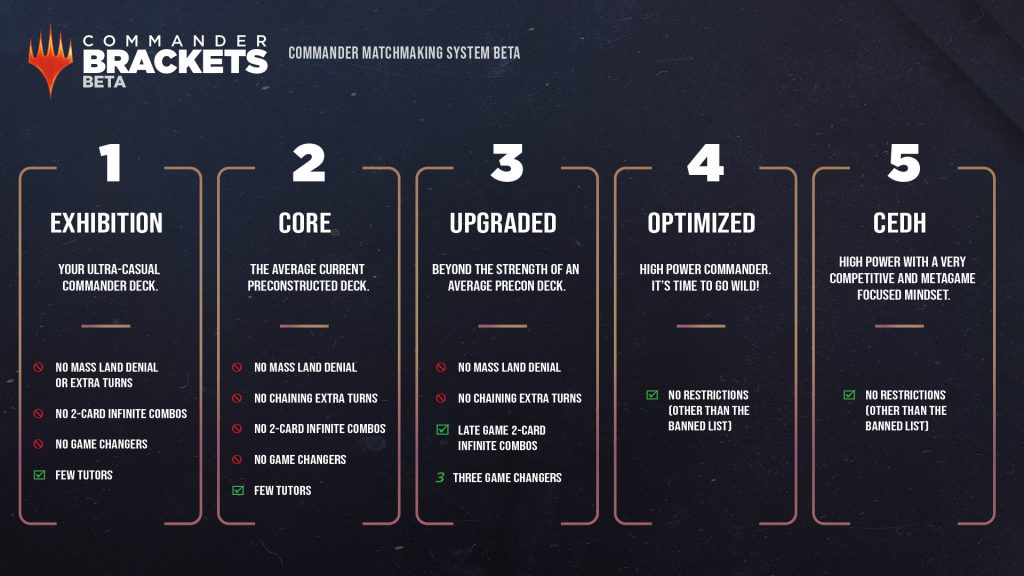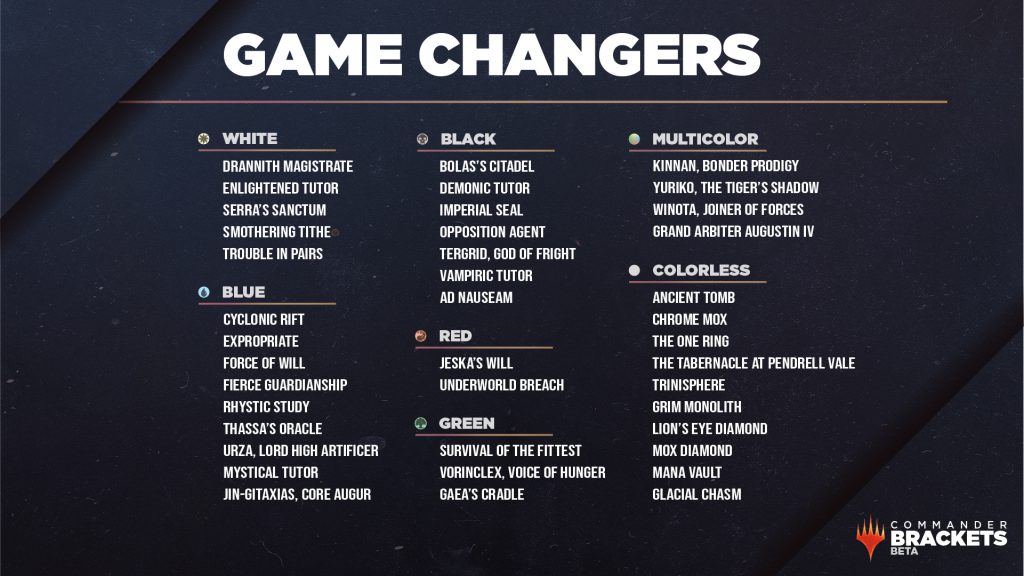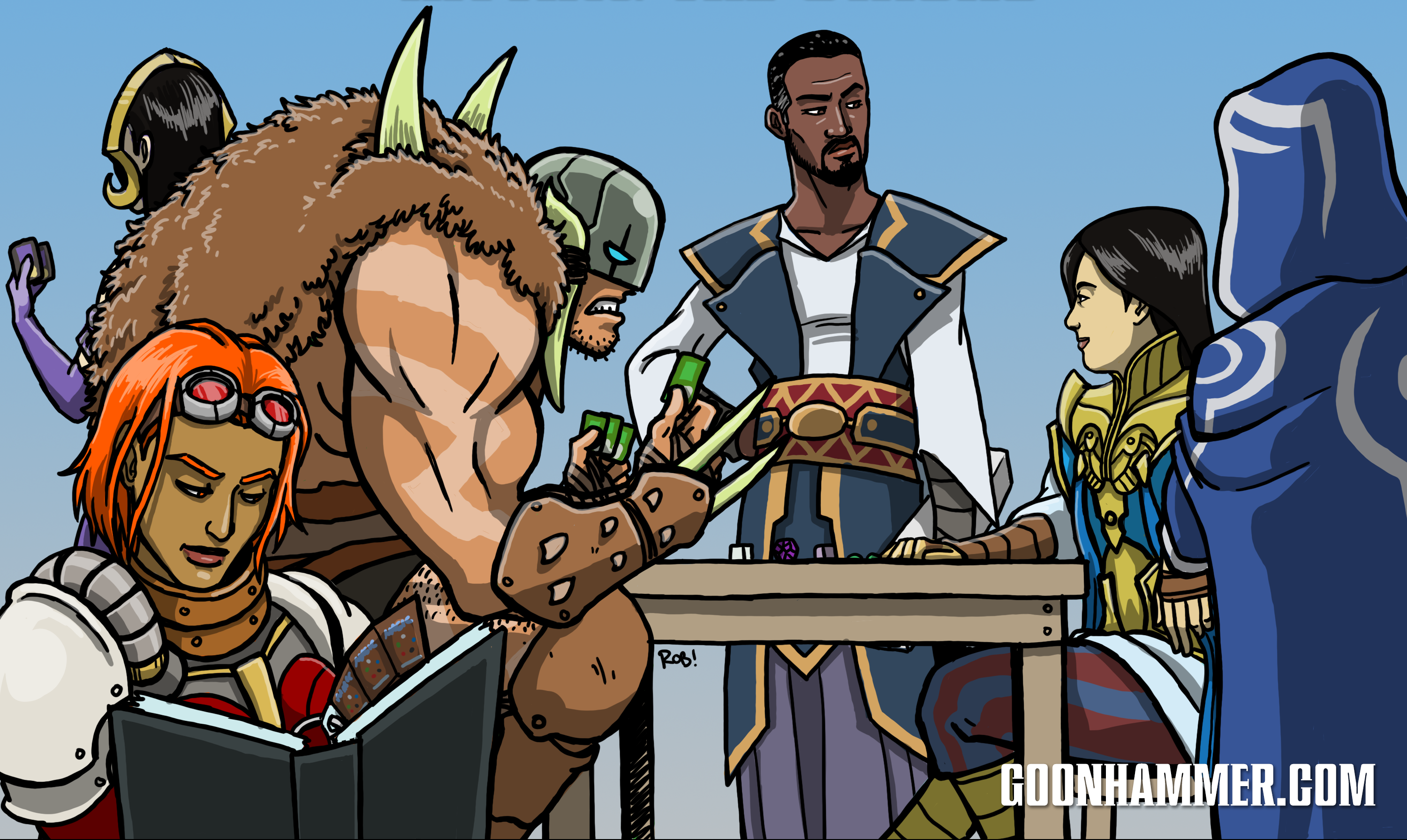This week Wizards of the Coast finally unveiled their first Beta Test of the brackets/tier system for the Commander format. In case you missed the announcement, you can find it here.
If you’re looking for the short version, the system loosely involves five brackets with what may be best described as different “vibes” and a list of cards that have been labeled Game Changers. These Game Changers are only relevant in Brackets 1, 2, and 3, in that they’re banned in Brackets 1 and 2 and limited to three total copies of them in Bracket 3. There are no card restrictions above Bracket 3, save for cards on the Banned list. Beyond those card restrictions, there are some other guidelines for brackets 1-3, such as not allowing “mass land denial” or “two card infinite combos.”
If these latter guidelines sound a bit vague, that’s because they are. Wizard apparently seems to still be leaning on the notion of there being a “rule zero” in games. They’ve noted several important mechanical concepts which define games here, such as extra turn spells, mass land destruction, tutors, and two-card infinite combos, but these aren’t always well-defined, i.e. Brackets 1 and 2 have “Few Tutors” as guidelines.
Let’s run through these brackets and talk about the guidelines for each and what they might actually entail in play.

Bracket 1: Exhibition
Intended Experience: Throw down your ultra-casual Commander deck!
This is billed as the bracket for “ultra-casual Commander decks,” where winning isn’t the primary goal as much as showing off something you’ve done. No cards from the Game Changers are allowed, and tutors should be sparse. It’s actually difficult to imagine building a functional Magic deck for this bracket, given that the level here is supposedly below that of a Preconstructed Deck, so some of this is bound to be based on vibes, in that the vibe here is “no one is trying to win.”
Games in this bracket are likely to be very long games which may not have a lot of things actually happening. Games like this seems likely to end in a draw because someone has to leave or because the store is closing.
Bracket 2: Core
Intended Experience: The average current preconstructed deck.
This is going to be the bracket a lot of players start at, since buying a pre-constructed deck and playing with it out of the box is pretty common – though it’s worth noting that precons vary pretty wildly in terms of how strong and focused they can be. Decks at this level are going to be full of bad lands that enter tapped, mediocre overcosted creatures, multiple sub-themes with no synergy, and an excess of board clears. Any time you start to assemble a threatening board state, one of your opponents is likely to board wipe and reset things. This means longer, drawn-out games, but at least the decks will resemble something built with a nod toward a purpose.
No cards from the Game Changers list are allowed in this bracket.

Bracket 3: Upgraded
Intended Experience: These decks are souped up and ready to play beyond the strength of an average pre-constructed deck.
At this tier, you’re allowed three cards from the Game Changers list.
The new “my deck is a 7” is “my deck is a 3.” Virtually everything fits into this category unless you insist on running the game changers list, particularly since the use of “late-game” two-card infinite combos is allowed. This is one of the areas where things like “no mass land denial” and “no chaining extra turns” is going to have to do more vibes-based lifting than we’d like to see, because it’s not clear how say, BPhillipYork’s extremely competitive Najeela infinite combats deck would be received in this bracket.
Bracket 4: Optimized
Intended Experience: It’s time to go wild!
This is all vibes-based and if we’re honest, Bracket 4 is the least helpfully-defined bracket in the bunch. It looks like cEDH for people who are going to be frustrated by losing or complain about netdecks or meta-chasing when they do. This bracket seems like the most likely place for someone to insist after a loss that while your deck is CEDH, theirs is merely Optimized.
Bracket 5: CEDH
Intended Experience: This is high power with a very competitive and metagame focused mindset.
True cEDH. You know what you’re getting here, and that’s fine.
Thoughts
BPhillipYork: The Game Changers list is a good concept. Canadian Highlander is a good concept too. They could easily have combined them. Give game changers point costs, put the point costs into the brackets.
There’s two extremely important concepts missing from this entire article: ramp, and card draw. Several of the very best ramp cards are in the game changers list, however beyond that, all the 2 cost mana rocks and land tutors are completely legit. In addition I don’t see stax appearing anywhere on the list of issues. I can tell you virtually anyone playing at level 1 or 2 doesn’t want to deal with stax cards. There’s also some glaring holes, like Mystic Remora and Esper Sentinel.
Finally: Just ban Sol Ring cowards. Or at least restrict it to 3 and above.
Thankfully this is only a beta. Card brackets as a concept is an extremely useful good thing. Wizards needs to just step up and be more clear. Use literal definitions. Tell us what low quantities are. Two? Five? Tell us what a cheap infinite combo is. Is it 5 mana? 10? Is Exquisite Blood and Sanguine Bond still allowed because it costs 10? Yes, no mater how specific the rules are, they can be bent and ignored by someone. These rules are so vague as to be meaningless. When I see a card that costs 6 mana, I think that’s insanely expensive and for that much investment I should be getting very close to winning the game. Other people see an exciting opportunity to lay down 6 damage a turn.
Some basic suggestions:
- “Cheap” two-card infinite combos means 8 converted mana cost or less.
- “Low quantity” extra turn spells means three or fewer.
TheChirurgeon: The Game Changers list is a solid idea though the actual list is a bit weird to me. I agree that ramp and draw are missing (Sol Ring should be a game changer), and it’s kind of baffling to not see anything Stax related on here, given how painfully unfun most people find it to play against Stax decks. And while I’m generally am not a fan of the people who complain about counterspells, there are enough people who get upset by them that I’m surprised there isn’t more restricting them. While I’m on that topic, Force of Will being a game changer seems pretty wild.
On the whole I think this a solid first attempt. The big issue seems to be that it’s trying too hard to live on vibes. It doesn’t quite do enough to stop degenerate cards from leaking to lower levels and there are too many areas where they are too vague to be helpful – what exactly does “tutors are sparse” mean? Is two tutors sparse? Three? Five? Also why say things like “extra-turn cards are not intended to be chained in succession or looped” and just put an actual rule cap on the number of consecutive turns you can play in those lower levels?
Loxi: I’m going to get to the point first and then go into more details – I think this is a very good step in the right direction for the purpose of sitting down with strangers at an LGS and having a better attempt at a balance game. The key word there is better: I don’t think this is an attempt at perfectly balanced matched-play type scenarios, it’s just a way to make sure there are less chances for people to get blown out of the water from mutual misunderstandings of how other players’ decks will function. It’s not going to alleviate every feels-bad game or card from each bracket right off the bat, but I think starting conservatively is a better call than going too aggressive considering the recent reactions the overall commander community has had to change have been…contentious to say the least.
As far as the brackets themselves go, I think the general blocks they’re going for seem pretty solid to start. 2 being preconstructed level is already a common baseline people use for decks, so I don’t think this changes much. I do think having a power level below that is a bit arbitrary; even though precons have improved over the years significantly, I think they still are lower on the general power scale of deck tuning and folks playing below that are likely not going to care/pay attention to power brackets like this. Most of the discussion I’ve seen around bracket 1 is people intentionally wanting to try and build the best deck they can in that bracket restriction, and while that seems sweet and I 100% want to try that myself, it somewhat defeats the point of that type of gameplay experience they’re pointing towards with “kitchen table piles” being addressed.
The Game Changers list is interesting because it seems to really only clip out the very top end of powerful archetypes of cards – there are still quite a few powerful ramping, drawing, and tutoring methods this doesn’t touch, so I hope this doesn’t just shift people towards using those and making archetypes that can access them (i.e. a lot of the green and blue tutors for creatures, artifacts, and instant/sorceries) stand out more. Things like extra combats and token-generation loops are a bit left out of the light here as well. I think a lot of the discourse will come down to power brackets 3 still having the opportunity for a lot of disparity between deck power, since the jump between bracket 2 and bracket 3 can be pretty steep if people are tuning themselves to have a deck that is an “optimal 3.” I do hope they go a bit deeper on defining the difference between brackets 4-5 for new players so they understand the vibes of cEDH, since I do feel like a good chunk of people who have not played cEDH themselves don’t quite get how that slants away from just “high power” EDH tables.
Overall, I’m really happy to see this. I have had a lot of really bad games from sitting down with folks and them (or myself) over/under assessing the decks at play, and one player sometimes ends up just having a nothing-game because their deck was too divergent from what the rest of the table was playing. This strives to alleviate those types of environments and have a more clear onboarding point for new players, which is really cool to me. With big sweeping changes, it’s always important to remember to seek progress, not perfection.
FromTheShire: I agree that this is a really solid starting point for a beta system. Avid Commander Vs viewers who want to play their Chair Tribal or Ladies Looking Left style meme decks will be happy to have a carve out, and I could also see decks like Shivam Bhatt’s old Jedit Ojanen build or my own Lady Caleria Archer tribal going here. Sometimes it’s fun to build with crazy restrictions and old, lower powered cards that hearken back to when many of us started playing and the feel of old battlecruiser Elder Dragon Highlander. Honestly I could even see some of the original precons being in tier 1, before they started giving them better mana bases and general power creep took hold. Tier 2 will be interesting as time goes on, like do they have a plan for updating what a “current” average power level is? 3 and 4 kind of blend together on the low end, and 4 and 5 can on the top end as well, though I think generally if you’re running a 5 and trying to convince people it’s a 4 you know what you’re doing, and as they rightly point out at the end of the day Wizards can’t stop people from bending the intent and being shitheads.
There’s a lot of people purposely trying to be disingenuous and show off how busted of a deck they can make in a lower tier, but that’s kind of the point – you’re deliberately doing it and that’s something that’s always been true, not simply with this proposed system. I think that no matter what system is used by Wizards or the community, the game is simply too complex and the card pool too large to be able to rigidly control exact power levels. While it may not feel ideal, a certain level of “vibes” is always going to be baked in, and this seems like a good beginning for figuring out how to roughly tier people sitting down together for the first time at an LGS.
I will say that I don’t particularly care for specifically the name Game Changers and how often everyone under the sun is going to be doing Sam Reichman impressions, though some of the alters I’ve already seen have given me a chuckle.
Have any questions or feedback? Drop us a note in the comments below or email us at contact@goonhammer.com. Want articles like this linked in your inbox every Monday morning? Sign up for our newsletter. And don’t forget that you can support us on Patreon for backer rewards like early video content, Administratum access, an ad-free experience on our website and more.


